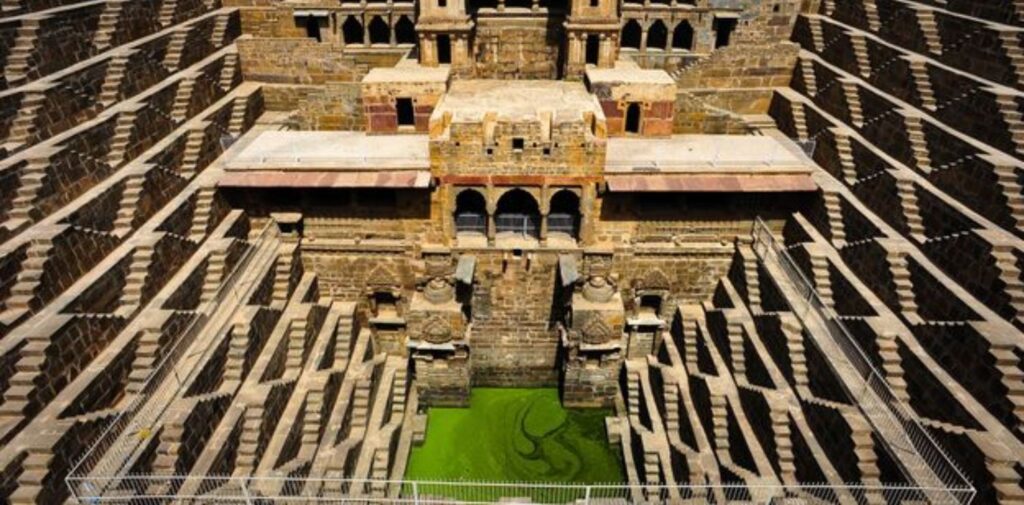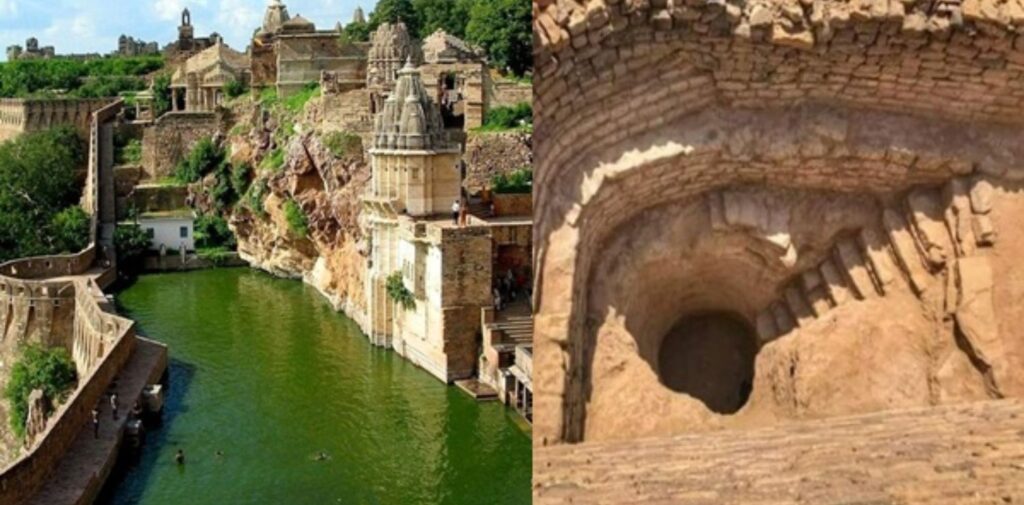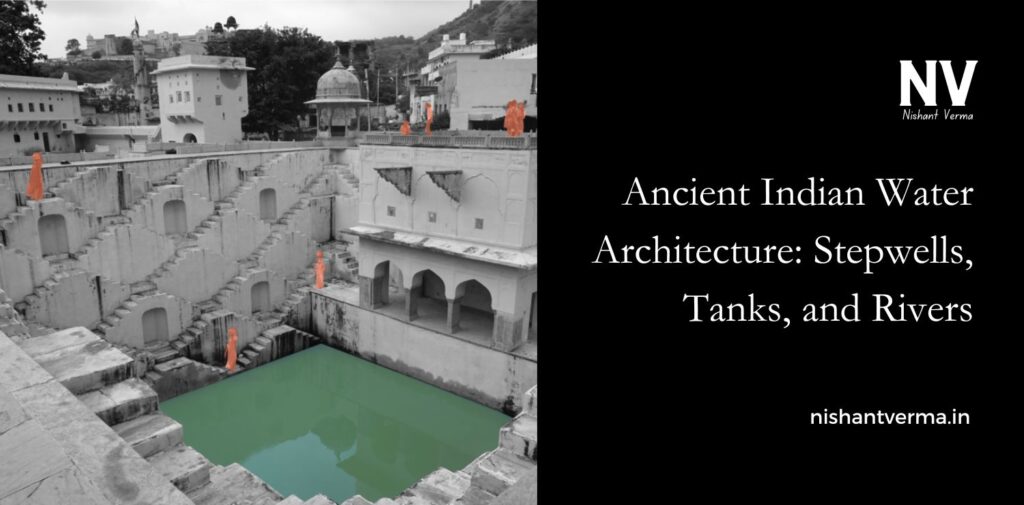India is a land of rich culture and history, and one important part of its heritage is the way ancient people managed water. Water has always been a precious resource in India, and throughout history, people have created amazing structures to collect, store, and manage water. In this article, we will learn about three important types of water architecture from ancient India: step-wells, tanks, and rivers. These structures helped people survive in dry regions, support agriculture, and improve daily life.
Stepwells: Water Stored Below the Ground
Stepwells, also known as “Baolis” or “Vav,” are one of the most interesting and unique water structures in India. These are deep wells that have steps going down into them. The steps lead down to the water, which is usually found many feet below the ground surface. Stepwells were built in areas where there was little rain, and they helped people access underground water.

How Stepwells Work
In ancient times, step-wells were not just a place to store water; they were also designed in a way that people could easily reach the water even during hot summers. The steps went deep into the well, and as the water level went down, the steps allowed people to walk down and collect water. Some stepwells were large enough to store thousands of gallons of water, and many of them were beautifully decorated with carvings and sculptures.
Famous Stepwells
One of the most famous step-wells in India is the Rani Ki Vav in Gujarat. It is considered one of the finest examples of Stepwell architecture. The stepwell is so big and beautiful that it was even listed as a UNESCO World Heritage Site. Another famous stepwell is the Adalaj Vav, also in Gujarat, which is known for its intricate carvings and design.
These stepwells were not just functional but also served as places for social gatherings and religious rituals. People would come to these step-wells not just to fetch water but also to meet others and spend time in the cool underground surroundings.
Tanks: Storing Water for Everyone
Water tanks, or “Jhalaras” as they are sometimes called, are large water reservoirs built on the surface of the earth. Unlike step wells, which go deep into the ground, tanks are built above the ground and collect rainwater, or water from nearby rivers, streams, or channels. Tanks were built in places that didn’t have natural lakes or rivers, and they served as a source of water for drinking, washing, and irrigation (watering crops).
How Tanks Are Built
Tanks are usually made with stone or brick walls, and they are designed to collect water during the monsoon season. They have a large open area where water can be collected, and the sides of the tank are sometimes designed with steps, making it easy for people to walk down and collect water. Tanks could vary in size, from small ones for villages to large ones for big cities or palaces.
Famous Tanks
One famous tank is the Pushkar Lake in Rajasthan. Pushkar is a holy place for Hindus, and the lake is surrounded by temples and beautiful steps that lead down to the water. Another famous tank is the Tank at Chittorgarh Fort, which was built for the royal family to provide water during times of war and siege.
Tanks were an important part of Indian cities and villages. They helped people store water and use it during the dry season. In ancient India, the management of water tanks was a community effort, and local people worked together to maintain these tanks to ensure there was enough water for everyone.

Rivers: Lifelines of Ancient India
In addition to step-wells and tanks, rivers were also very important for water supply in ancient India. Rivers like the Indus, Ganga, and Yamuna have been central to Indian civilization for thousands of years. These rivers provided water for drinking, irrigation, and transportation.
How Rivers Helped Ancient India
Ancient Indians built many cities and towns along the banks of rivers. The river water was used for daily needs, and it also helped in growing crops. People even used rivers for travel and trade. The banks of rivers were often developed into large cities, and the water was used to irrigate farmland, which allowed people to grow rice, wheat, and other crops. This helped the economy grow and supported the large population of ancient India.
Famous Rivers
The Ganges River, or Ganga, is one of the most famous and sacred rivers in India. It is considered a goddess by Hindus, and millions of people visit the river every year to bathe in its waters. Ancient cities like Varanasi, Prayagraj, and Haridwar were built on the banks of the Ganges, and these cities became important cultural and religious centres.
The Indus River is another important river in Indian history. The Indus Valley Civilization, one of the oldest civilizations in the world, grew along the Indus River. Cities like Mohenjo-Daro and Harappa were developed near this river. The people of the Indus Valley used the river for drinking, cooking, and irrigation. They built sophisticated systems of drains and water management around the river to make sure water was used wisely.
Importance of Water Architecture in Ancient India
Water management in ancient India was not just about finding ways to store water; it was about creating systems that helped people live better lives. The architecture of step-wells, tanks, and the use of rivers showed that ancient Indians understood the importance of water for survival, agriculture, and culture.
Water for Survival and Growth
Water was crucial for survival, especially in dry regions where there was little rainfall. The people of ancient India built step-wells and tanks to store water during the monsoon season, ensuring that they had water during the dry months. Rivers helped people grow crops by providing water for irrigation. Without these systems of water management, life in ancient India would have been much harder.

Water for Social and Religious Life
Water also played an important role in social and religious life. Stepwells were often places where people gathered, met each other, and performed rituals. Tanks and rivers were considered sacred, and many religious ceremonies and festivals were held around these water bodies. For example, the Ganges River is considered a holy river by Hindus, and millions of people travel to its banks every year to perform religious ceremonies.
Conclusion: Ancient Indian Water Architecture
The water architecture of ancient India, such as step-wells, tanks, and rivers, was not just about building structures; it was about understanding the importance of water for life. These structures were designed to collect, store, and manage water in a way that helped people survive, grow food, and live together in harmony. Today, many of these ancient water systems are still admired for their beauty and engineering skills.
Learning about these ancient water architectures helps us understand how people in ancient India were able to live in challenging environments and create a thriving civilization. Even today, we can learn from their wisdom and work towards better water management to help people all around the world.




